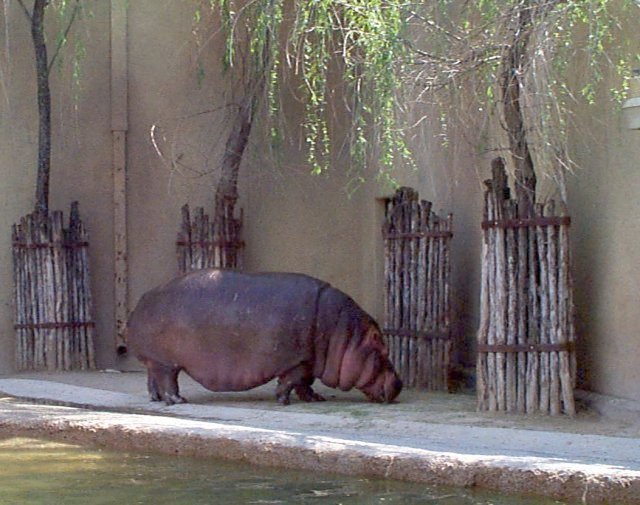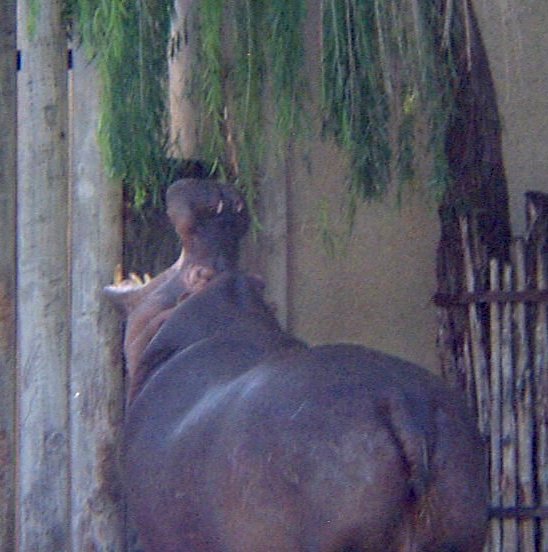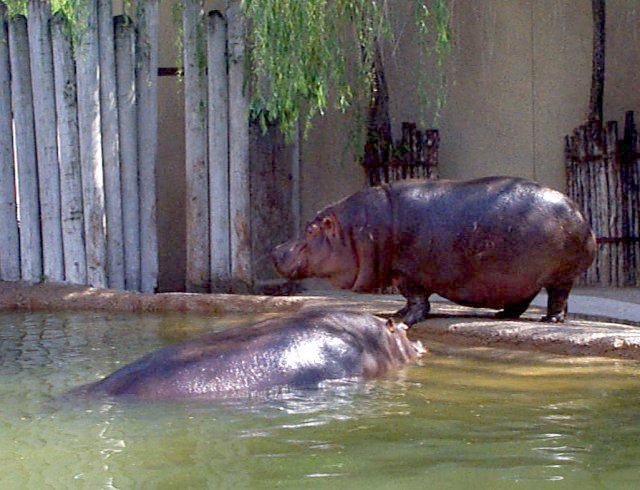| General
Information |

|
- Name: Hippopotamus
- Scientific name: Hippopotamus
amphibius
- Range: Africa, below the Sahara
to above the southernmost section
- Habitat: Large to small bodies of
water with flat banks bordering rich grass plains
- Status: Not threatened
- Diet in the wild: Soft short grass,
and other plants, and fruits that have fallen
- Diet in the zoo: Herbivore diet
- Location in the Zoo: African
Savannah
|
|
Physical
Description and What the Hippo Eats
 The
Hippopotamus is an extremely fat animal, with a round body, short, stocky
legs, and a large head. Female Hippos are usually slightly smaller than
the male Hippos. The male Hippo can grow up to twelve feet long and five
feet high, and can weigh up to 8,000 pounds. The female Hippo, however,
is slightly smaller. The Hippo's body is a brownish-gray color on top,
and paler on the underside, with pink areas on the face. The
Hippopotamus is an extremely fat animal, with a round body, short, stocky
legs, and a large head. Female Hippos are usually slightly smaller than
the male Hippos. The male Hippo can grow up to twelve feet long and five
feet high, and can weigh up to 8,000 pounds. The female Hippo, however,
is slightly smaller. The Hippo's body is a brownish-gray color on top,
and paler on the underside, with pink areas on the face.

In the wild the Hippopotamus eats
soft grasses and other low lying plants, aquatic and reed plants, leaves,
and fallen fruits. While in the zoo, however, the hippopotamus eat a
herbivorous diet. The hippopotamus will occasionally eat cultivated
crops such as corn and sugar cane.
|
Special
Anatomical, Physiological,
or Behavioral Adaptations

- Eyes, ears, and nose of the animal are high
on the face, allowing the animal to be almost totally submerged when
it is in the water.
- The Hippopotamus spends their day lying in
the water, with oily secretions helping protect the skin from the sun.
- Hippos spend their nights grazing.
- The Hippo rivals the Rhinoceros for the title
of the second largest land mammal.
- The stomach of the Hippo has three chambers,
but is non-ruminating.
- The life span of the animal is 35 to 50 years.
|
Personal
Observations

The Hippopotamus spent the entire time
in the water while I was there. Other than coming up for a breath of air
every now and then, the Hippo may have moved may be twenty feet. There
are two Hippopotamuses currently at the zoo and both of the animals seem
to be extremely fat. The skin is dark and hairy. The Hippopotamuses were
in the water for so long that there was nothing to really record because
I could not see them. I can see the troubles researchers can have in doing
research on the animal. Since the animal spends most of the day in the
water and comes out at night graze, it causes a problem in doing field
research. |
Vocalizations

Dr. William Barklow has spent many years
studying the vocalizations of hippos. These are rarely heard by humans
since most of them occur underwater, but calls as loud as 115 DB have
been recorded. Hundreds of different calls have been identified. These
calls may function like bird calls, as a means of social communication.
|
|
|
Sources
of Information
The
San Francisco Zoo:
http://www.sfzoo.org/cgi-bin/animals.py?ID=64
The National
Zoo
http://nationalzoo.si.edu/Animals/AfricanSavanna/fact-hippo.cfm
The
University of Michigan:
http://animaldiversity.ummz.umich.edu/accounts/hippopotamus/h._amphibius.html
Hippo Facts
http://www.savethehippos.com/information.html
Hippo
Courtship video at the Smithsonian Web Site
http://www.smithsonianmag.si.edu/smithsonian/issues96/mar96/movies/courting.mov
Download the free Quicktime
Player
Klingel,
Hans. "Fluctuating Fortunes of the River Horse."
Natural
History, Vol. 104 (5): 46-57. May 1995.
Hans
Fradrich, Ernst M. Lang. "Hippopotamuses"
Grzimek's
Animal Life Encyclopedia. Vol. 13, Mammals
IV. 1972.
|
|
Page
Author: Seth Herrick

E-mail
me: sethh@flash.net
|
| |
|
 Hippopotamus
Hippopotamus 